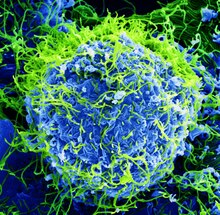
Back فيروس إيبولا زائير Arabic ইবোলা ভাইরাস Bengali/Bangla Zaire ebolavirus Catalan Zaire-Ebolavirus German Ebolavirus Zaire Spanish ویروس ابولا Persian Ebolavirus Zaïre French Zaire ebolavirus Italian Ebolavirus zairense Latin Zaire ebolavirus Malay
| Zaire ebolavirus | |
|---|---|

| |
| Colorized scanning electron micrograph of Ebola virus particles (green) found both as extracellular particles and budding particles from a chronically infected African Green Monkey Kidney cell (blue); 20,000x magnification | |
| Virus classification | |
| (unranked): | Virus |
| Realm: | Riboviria |
| Kingdom: | Orthornavirae |
| Phylum: | Negarnaviricota |
| Class: | Monjiviricetes |
| Order: | Mononegavirales |
| Family: | Filoviridae |
| Genus: | Ebolavirus |
| Species: | Zaire ebolavirus
|
Zaire ebolavirus, more commonly known as Ebola virus (⫽iˈboʊlə, ɪ-⫽; EBOV), is one of six known species within the genus Ebolavirus.[1] Four of the six known ebolaviruses, including EBOV, cause a severe and often fatal hemorrhagic fever in humans and other mammals, known as Ebola virus disease (EVD). Ebola virus has caused the majority of human deaths from EVD, and was the cause of the 2013–2016 epidemic in western Africa,[2] which resulted in at least 28,646 suspected cases and 11,323 confirmed deaths.[3][4]
Ebola virus and its genus were both originally named for Zaire (now the Democratic Republic of the Congo), the country where it was first described,[1] and was at first suspected to be a new "strain" of the closely related Marburg virus.[5][6] The virus was renamed "Ebola virus" in 2010 to avoid confusion. Ebola virus is the single member of the species Zaire ebolavirus, which is assigned to the genus Ebolavirus, family Filoviridae, order Mononegavirales. The members of the species are called Zaire ebolaviruses.[1][7] The natural reservoir of Ebola virus is believed to be bats, particularly fruit bats,[8] and it is primarily transmitted between humans and from animals to humans through body fluids.[9]
The EBOV genome is a single-stranded RNA, approximately 19,000 nucleotides long. It encodes seven structural proteins: nucleoprotein (NP), polymerase cofactor (VP35), (VP40), GP, transcription activator (VP30), VP24, and RNA-dependent RNA polymerase (L).[10]
Because of its high fatality rate (up to 83 to 90 percent),[11][12] EBOV is also listed as a select agent, World Health Organization Risk Group 4 Pathogen (requiring Biosafety Level 4-equivalent containment), a US National Institutes of Health/National Institute of Allergy and Infectious Diseases Category A Priority Pathogen, US CDC Centers for Disease Control and Prevention Category A Bioterrorism Agent, and a Biological Agent for Export Control by the Australia Group.[citation needed]
- ^ a b c Kuhn JH, Becker S, Ebihara H, Geisbert TW, Johnson KM, Kawaoka Y, Lipkin WI, Negredo AI, et al. (2010). "Proposal for a revised taxonomy of the family Filoviridae: Classification, names of taxa and viruses, and virus abbreviations". Archives of Virology. 155 (12): 2083–2103. doi:10.1007/s00705-010-0814-x. PMC 3074192. PMID 21046175.
- ^ Na, Woonsung; Park, Nanuri; Yeom, Minju; Song, Daesub (4 December 2016). "Ebola outbreak in Western Africa 2014: what is going on with Ebola virus?". Clinical and Experimental Vaccine Research. 4 (1): 17–22. doi:10.7774/cevr.2015.4.1.17. ISSN 2287-3651. PMC 4313106. PMID 25648530.
- ^ Ebola virus disease (Report). World Health Organization. Retrieved 6 June 2019.
- ^ "Ebola virus disease outbreak". World Health Organization. Retrieved 4 December 2016.
- ^ Cite error: The named reference
Pattyn1977was invoked but never defined (see the help page). - ^ Cite error: The named reference
Bowen1977was invoked but never defined (see the help page). - ^ WHO. "Ebola virus disease".
- ^ Quammen, David (30 December 2014). "Insect-Eating Bat May Be Origin of Ebola Outbreak, New Study Suggests". news.nationalgeographic.com. Washington, DC: National Geographic Society. Archived from the original on 31 December 2014. Retrieved 30 December 2014.
- ^ Angier, Natalie (27 October 2014). "Killers in a Cell but on the Loose – Ebola and the Vast Viral Universe". New York Times. Retrieved 27 October 2014.
- ^ Nanbo, Asuka; Watanabe, Shinji; Halfmann, Peter; Kawaoka, Yoshihiro (4 February 2013). "The spatio-temporal distribution dynamics of Ebola virus proteins and RNA in infected cells". Scientific Reports. 3: 1206. Bibcode:2013NatSR...3E1206N. doi:10.1038/srep01206. PMC 3563031. PMID 23383374.
- ^ "Ebola virus disease Fact sheet N°103". World Health Organization. March 2014. Retrieved 12 April 2014.
- ^ Fauquet CM, Mayo MA, Maniloff J, Desselberger U, Ball LA, eds. (2005). Virus Taxonomy – Eighth Report of the International Committee on Taxonomy of Viruses. Oxford: Elsevier/Academic Press. p. 648. ISBN 978-0080575483.